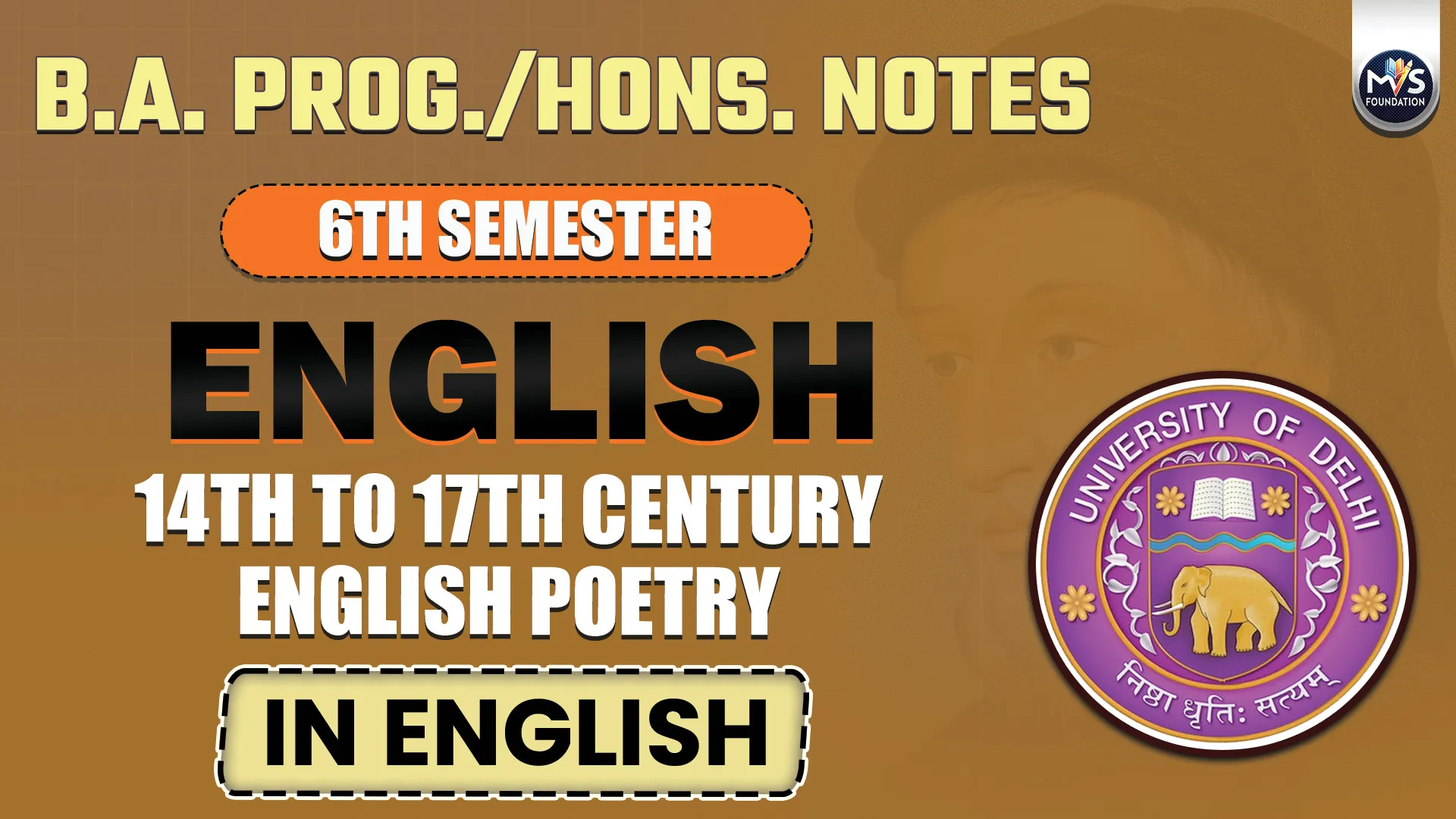Q1. (a) Identify the lines below and critically comment on Chaucer's literary portraits.
"Me thynketh it acordaunt to resoun
To telle yow al the condicioun
Of ech of hem, so as it semed me,
And whiche they weren, and of what degree,
And eek in what array that they were inne;"
Answer -
Introduction
In the General Prologue of The Canterbury Tales, Chaucer talks about 29 people going on a religious journey to the shrine of Saint Thomas Becket at Canterbury.
This was a common trip in medieval England. Chaucer uses this journey to bring together people from different backgrounds, jobs, and social classes. He plans to describe each person's looks, personality, and way of life. His descriptions are clear, funny, and full of meaning. Through these characters, Chaucer shows what life was like in 14th-century England in a simple and realistic way.
Click Here For Full Notes
"About The Author"
Geoffrey Chaucer (1343-1400) is called the 'Father of English literature' and is one of the earliest great poets to write in English. He is best known for his famous work The Canterbury Tales. Chaucer wrote in Middle English, mixing in Latin and French words. His poetry gives great joy and a lively picture of 14th-century English life.
"Description of Given Stanza"
"Me thynketh it acordaunt to resoun / To telle yow al the condicioun / Of ech of hem, so as it semed me, / And whiche they weren, and of what degree, / And eek in what array that they were inne;"
Explanation: "Me thynketh it acordaunt to resoun" Chaucer (pilgrim) says, "It seems reasonable to me." He feels it is logical and fitting to describe the pilgrims.
These lines shows Chaucer's clear intention to describe each pilgrim honestly and in detail. He wants to tell us who they are, what their background is, which social class they belong to, and how they appear outwardly. This shows his plan to paint complete and realistic pictures of the people around him. The narrator says it makes sense ("accordaunt to resoun") to describe each pilgrim's "condicioun," or character.
- "To telle yow al the condicioun" This means, "To tell you the condition or nature of each person." Here, "condicioun" refers to each pilgrim's character, background, personality, and possibly moral nature. For example, the Knight is shown as brave and modest, while the Wife of Bath is bold and experienced in love and marriage. Each portrait feels personal and full of life.
- "Of ech of hem, so as it semed me," This means, "Of each of them, just as it appeared to me." Chaucer explains that he is describing the pilgrims as they appeared to him. These are his own observations, not facts or exact truth.
"And whiche they weren, and of what degree," This means, "And who they were, and what social rank or class they belonged to." Chaucer promises to tell the readers not just the names or types of people, but also their social status, which was very important in medieval society.
- "And eek in what array that they were inne;" This means, "And also what kind of clothes or appearance they had." "Array" refers to their dress, manner, and presentation-what they wore and how they looked, which often reflects their profession, wealth, or pretensions.
Click Here For Full Notes
"Critical Commentary on Chaucer's Literary Portraits"
1. Chaucer's Use of Realism and Social Diversity
- Chaucer's The Canterbury Tales gives us a clear and lively picture of 14th-century English society. Instead of only showing perfect or ideal people, Chaucer shows his characters as real and believable, with strengths and weaknesses. He includes people from all parts of society like nobles (the Knight), church members (the Parson and the Monk), the middle class (the Merchant and the Franklin), and working-class people (the Miller and the Ploughman).
- Each character has their own look, personality, and social background. For example, the Knight is described as a true and noble man who follows the rules of chivalry. But the Miller is loud, rude, and funny, showing the rough side of the lower class. These different characters show that Chaucer wants to represent many types of people, not just good or bad ones.
- Chaucer makes his characters feel real by describing their clothes, the way they speak, and what they do. For example, the Wife of Bath wears bright clothes and talks openly about her five husbands. This shows she is bold and confident. Chaucer's writing feels realistic not just because he includes different types of people, but also because he shows their thoughts and personalities. This was a big change in English literature. Earlier stories were mostly about good behavior, but Chaucer started focusing more on the people themselves.
2. Use of Irony and Satirical Tone
- A special feature of Chaucer's writing is how cleverly he uses irony and satire. Instead of directly criticizing people, he uses a light and funny tone. He shows the difference between what a person is supposed to be (like their job or role in society) and how they actually behave. This helps readers see their faults or hypocrisy without Chaucer having to say it clearly. This smart and subtle way of showing the truth is called "Chaucerian irony."
- For example, the Friar is shown as a cheerful and friendly man who prefers spending time in bars rather than helping the sick or poor. Even though, as a religious figure, he is supposed to be humble and caring, he avoids those in need. Instead, he flirts with women and tricks people into giving him money through false confessions. Chaucer's narrator calls the Friar "a noble pillar of the order," which at first sounds like a big compliment. But the praise is so over-the-top that it actually becomes a funny way to show what the Friar is really like. This is an example of Chaucerian irony, where Chaucer uses gentle humor to show the truth.
- The Pardoner is a church official who tricks people by selling fake holy objects and preaching just to make money. Though he looks nice and speaks well, he is actually greedy and dishonest. Chaucer says the Pardoner can make people feel sorry and generous, but really he only cares about money. The Pardoner's long yellow hair and lack of beard suggest he doesn't fit normal ideas of masculinity, making him seem even less trustworthy. This use of irony makes readers look beyond appearances to find the real truth. Through satire, Chaucer quietly criticizes the Church and other powerful groups, showing their flaws and pretensions.
3. Use of Descriptive Detail and Symbolism
- Chaucer makes his characters more interesting by using clear descriptions and symbols that show deeper meanings. The clothes, looks, and things the pilgrims carry often tell us about their morals or social position. For example, the Monk wears fancy clothes with fur and a gold pin shaped like a love knot. This is very different from how a poor, serious monk should look, showing that he cares more about the world than religion. The Wife of Bath wears bright red stockings and a big hat, showing that she is bold and independent, especially about love and marriage. The Summoner has a red, pimply face and ugly eyebrows, which show his sinful and corrupt nature. He looks like a walking warning about bad behavior. These details are not just to make the characters easy to picture-they also tell us about their behavior and role in society. Chaucer uses these images to help us understand the characters better, beyond how they look.
Conclusion:
Chaucer's portraits of the pilgrims are detailed, honest, and full of life.
Through simple words, humor, and hidden criticism, he shows both individuals and society. His characters represent different classes and human behaviors, making them feel real. Chaucer's style of writing made a big impact and still helps us understand life in 14th-century England.
Click Here For Full Notes

